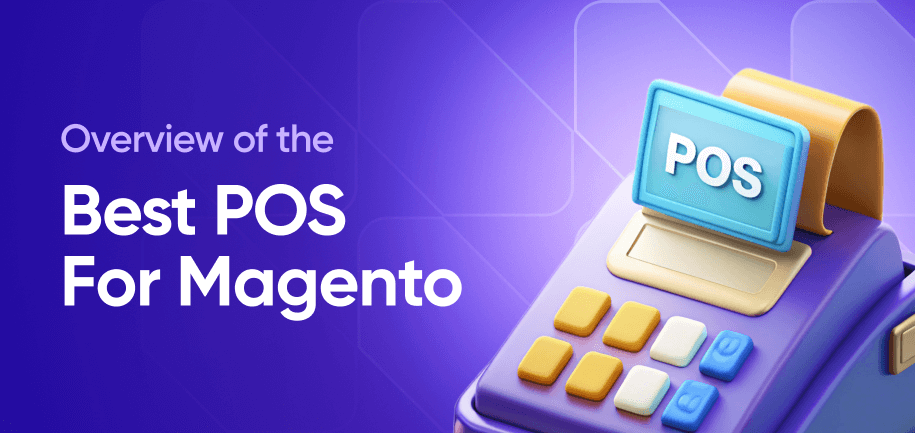According to Statista, global e-commerce sales are projected to surpass $8 trillion by 2027, which shows that online shopping continues to grow and become more complex. As this expansion occurs, many businesses struggle to manage Magento 2 order flows because of inefficient processes and confusion around status flows.
This article offers a detailed guide to optimize Magento 2 order management, so businesses can streamline operations and improve customer satisfaction.
What Is Order Flow in Magento 2?
Magento 2 order workflow refers to the process that handles customer orders from the moment they are placed until fulfillment. It includes several stages, such as order creation, payment processing, inventory management, shipping, and delivery.
Magento 2 default order workflow:
Order Placement – Customers place an order, which gets recorded in the system.
Order Processing – The system checks inventory, and processes payments.
Order Fulfillment – Items are picked, packed, and shipped to the customer.
Order Completion – The order status is updated to 'complete' once delivered.
Magento 2 Order Processing Workflow: Step-by-Step Breakdown
Understanding the order processing workflow in Magento 2 is important for managing transactions efficiently and ensuring customer satisfaction. Here’s a comprehensive breakdown:
Order Placement
Customers browse the store, add products to their cart, and proceed to checkout. Once the order is submitted, Magento records it in the system, capturing all necessary details like items purchased, customer information, and preferred payment method.
New Order Status
The new order enters the system with a "Pending" status. At this point, the system awaits payment authorization and further actions. This stage is crucial for validating the order and ensuring it aligns with inventory and pricing.
Payment Authorization
Magento communicates with the payment gateway to authorize the transaction. This step confirms that the customer has sufficient funds but does not withdraw the amount yet. It ensures the transaction's legitimacy and reduces risks of fraudulent orders.
Invoice Creation
Once payment is authorized, Magento generates an invoice, converting the order into a formalized record. This action captures the payment, committing funds from the customer's account and marking the transaction as financially settled.
Shipment Generation
With payment secured, the order moves to fulfillment. Products are picked from inventory, packaged, and shipped. Magento updates the order status to "Shipped" and provides tracking information to keep customers informed about their delivery.
Order Completion
After the shipment is delivered, the order status changes to "Complete." This indicates the successful conclusion of the transaction, with both payment and delivery finalized, enhancing customer confidence in the service.
Credit Memo (Optional)
In cases of returns or refunds, a credit memo comes into play. This document adjusts the transaction, allowing for a partial or full refund to the customer, ensuring flexibility in post-transaction customer service.
Flowchart
[Order Placement]
--> [New Order Status]
--> [Payment Authorization]
--> [Invoice Creation]
--> [Shipment Generation]
--> [Order Completion]
--> [Credit Memo (Optional)]
Magento 2 Order Status Flow Explained
To manage orders efficiently in Magento 2, you need to distinguish between order status and state. The state reflects the overall condition of the order in the processing workflow, while the status gives specific details about each stage within that state.
Default order statuses:
Pending – The order has been placed by the customer but is awaiting payment authorization. It's the initial stage where orders are reviewed, and inventory checks commence.
Processing – Payment has been authorized, and the order is being prepared for shipment. This status indicates active engagement with fulfillment operations, such as picking and packing the items.
Complete – The order has been shipped and delivered to the customer. All associated transactions, including payment capture and shipment, are finalized, marking the end of the order lifecycle.
Closed – The order is closed due to reasons such as a full refund or chargeback. This status indicates that no further actions or transactions can be conducted on the order.
Customizing Magento 2 Order Status Workflow
Tailoring your order status workflow eliminates confusion, automates processes, and keeps customers informed at every stage. Here’s how to optimize it:
1. Create Custom Order Statuses
Magento 2 allows you to define custom statuses (e.g., "Awaiting Fulfillment" or "Ready for Pickup") to match your business processes.
Steps:
Navigate to Stores > Settings > Order Statuses
Click Create New Status
Enter a status code and label (e.g., awaiting_fulfillment)
Save your changes
2. Assign Statuses to States
Each status must link to a system state (e.g., Processing, Complete). This ensures proper workflow transitions.
How to assign:
Go to Stores > Settings > Order Statuses
Select an existing status or create a new one
Under Assignment, choose the appropriate state (e.g., assign "Ready for Pickup" to the Processing state)
3. Practical Use Cases
Awaiting Fulfillment – Indicates that an order has been received and paid for, but is waiting for the next steps in the fulfillment process, such as picking and packing.
Ready for Pickup – Signals that the order has been prepared and is ready for the customer to collect from the specified pickup location.
Awaiting Stock – Used when an order is pending due to out-of-stock items, alerting both staff and customers about inventory delays.
Quality Check – Order is being inspected for quality assurance before shipment, ensuring that customers receive defect-free products.
Packaging – The order is currently being packed for shipment, updating customers on its progress within the fulfillment center.
4. Tools to Assist
Magento Admin Panel – Provides a user-friendly interface to create, modify, and assign custom order statuses. Intuitive and accessible, making it easy for users of all technical levels to implement changes.
Magento Command Line Interface (CLI) – Allows advanced users to perform batch updates, automate tasks, and manage custom statuses through scripted commands. Saves time and reduces errors during bulk changes, ideal for developers and tech-savvy users managing large-scale operations.
Magento Order Management Best Practices
To effectively manage orders and ensure exceptional customer service, it's important to follow best practices that streamline your operations. Focus on optimizing these key areas:
Efficient Handling of Invoices, Shipments, and Refunds
Efficiently managing invoices, shipments, and refunds is important for maintaining order accuracy and customer satisfaction. Automate invoice generation upon payment authorization and ensure shipments include real-time tracking. Clear refund policies and prompt communication help build customer trust.
Automating Order Flow
Automation tools within Magento can significantly streamline order processing. Implement automated notifications and status updates to reduce manual intervention, improving efficiency and accuracy while freeing up resources for other tasks.
Inventory Management
Effective inventory management is key to fulfilling orders promptly. Use Magento's built-in tools to track stock levels, automate reordering, and avoid overselling. This ensures a smooth supply chain and enhances customer satisfaction.
Customer Communication
Maintain clear and consistent communication with customers throughout the order process. Use Magento’s notification features to update customers on order status, shipping timelines, and any potential delays to keep them informed and engaged.
Using Magento Commerce Features vs. Open Source
Choosing between Magento Commerce and Open Source depends on business needs. Magento Commerce provides advanced features like AI recommendations and business intelligence, ideal for larger enterprises. In contrast, Magento Open Source offers core functionalities and flexibility, suitable for small to medium-sized businesses seeking cost-effective solutions.
Security and Compliance
Ensure that your order management practices comply with industry standards and regulations, such as PCI DSS for payment security. Regularly update your Magento installation and use security patches to protect customer data and maintain trust.
Tools & Extensions to Improve Magento 2 Order Flow
You can improve your Magento 2 order flow effectively when you use the right tools and extensions. These modules help optimize order management:
Pre Order M2
The Pre Order M2 extension allows you to sell products that are out of stock or not yet released. This feature is particularly useful for managing inventory and maintaining sales momentum.
Benefits:
Customer Engagement – Keeps customers interested even if the product isn't available immediately, reducing lost sales.
Demand Forecasting – Helps gauge interest and plan future inventory based on pre-order numbers.
Cash Flow Improvement – Collect payments for future products, improving cash flow without current inventory.
Key features:
Set pre-order status for specific products or categories.
Customize pre-order messages to manage customer expectations.
Automatic notification to customers once the product is available.
Quick Order M2
The Quick Order M2 extension is designed for customers who know exactly what they want and need a fast, streamlined purchasing process. It's particularly beneficial for B2B customers or returning buyers with large orders.
Benefits:
Efficiency – Speeds up the ordering process by allowing bulk order entry through product SKU or name.
User Experience – Enhances the shopping experience for regular or wholesale customers who prefer quick transactions.
Error Reduction – Minimizes errors and time spent searching for products.
Key features:
Input multiple SKUs at once to add items directly to the cart.
Auto-suggestions for product names or codes to simplify the search.
Supports CSV file uploads for bulk ordering, making it ideal for large order volumes.
Find more solutions to streamline your workflow here.
Use Cases
Auto Status Updates – Automating status updates ensures customers receive timely information about their orders, reducing inquiries and improving satisfaction.
Order Tags – Use tags to categorize orders by priority, location, or any custom criteria. This enhances order organization and enables faster processing.
Automation – Implementing automation reduces manual tasks, minimizes errors, and accelerates the overall order process, freeing up resources for other business activities.
Magento Order Management Tutorial: Quick Start Guide
Get started with order management in Magento 2 with these essential steps:
Access the Orders Dashboard
Log in to your Magento Admin Panel
Navigate to Sales > Orders
View or Search Orders
Use filters (date, status, customer) to find specific orders
Click any order to see full details
Process a New Order
Update the status (e.g., from "Pending" to "Processing")
Add tracking numbers under Shipments
Handle Refunds
Select Credit Memos for returns/refunds
Specify refund amounts and reasons
Customize Workflows (Optional)
Create custom statuses via Stores > Order Status
Set up email notifications for status changes
Common Order Management Issues (and How to Fix Them)
Even well-configured Magento stores encounter order workflow snags. These are the most frequent culprits and proven solutions:
1. Orders Stuck in "Processing" Status
When orders remain indefinitely in "Processing" status, it’s typically due to incomplete payment authorization, inventory allocation errors, or interrupted workflow automation. This creates operational bottlenecks and delays fulfillment.
How to resolve:
Check Sales > Invoices for successful payment confirmation
Ensure stock wasn’t reserved but not deducted (Catalog > Inventory)
Confirm your cron.php runs every 5 minutes for async processes
Place test orders with different payment methods
2. Incorrect Status Mapping
Custom statuses sometimes break when they’re improperly linked to system states (like "Processing" or "Complete"), or when third-party extensions override default mappings.
How to resolve:
Audit status-state relationships under Stores > Order Statuses
Disable recently installed extensions to identify conflicts
Rebuild indexes via System > Tools > Index Management
Consult /var/log/system.log for state transition errors
3. Delayed Email Notifications
Customers receive order updates late when cron jobs aren’t frequent enough, SMTP services throttle emails, or template configurations contain errors.
How to resolve:
Set interval to */5 * * * * in your server’s crontab
Monitor pending emails in System > Message Queue
Use Marketing > Email Communications to send test messages
Confirm all placeholders (like {{var order_id}}) render correctly
Final Thoughts
Effective order management is the backbone of a successful e-commerce business. By optimizing your Magento 2 workflow, from customizing order statuses to troubleshooting common issues, you can reduce errors, speed up fulfillment, and improve customer satisfaction.
Need expert help? Contact our team of professionals for Magento optimization solutions.
Frequently asked questions
Order statuses in Magento 2 include Pending, Processing, Complete, Closed, Canceled, and On Hold. These statuses help track the progress of each order through the fulfillment process.
Order state is a broad category that describes the overall condition of an order (e.g., New, Processing). Order status provides a more detailed description within that state (e.g., Pending, Payment Review).
The order lifecycle in Magento 2 involves several stages: Order Placement, Payment Authorization, Processing, Shipment, and Completion. Each step is tracked through specific order states and statuses.
To change order status programmatically, use Magento's API or write a custom script. This involves loading the order object, setting the desired status, and saving the order. It’s essential to ensure proper validation and testing when implementing these changes.















